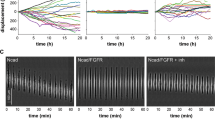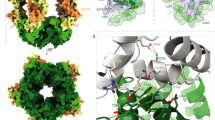Abstract
Fibroblast adhesion can be modulated by proteins released by neuroendocrine cells and neurons, such as chromogranin A (CgA) and its N-terminal fragment vasostatin-1 (VS-1, CgA1–78). We have investigated the mechanisms of the interaction of VS-1 with fibroblasts and of its pro-adhesive activity and have found that the proadhesive activity of VS-1 relies on its interaction with the fibroblast membrane via a phospholipid-binding amphipathic α-helix located within residues 47–66, as well as on the interaction of the adjacent C-terminal region 67–78, which is structurally similar to ezrin–radixin–moesin-binding phosphoprotein 50 (a membrane-cytoskeleton adapter protein), with other cellular components critical for the regulation of cell cytoskeleton.







Similar content being viewed by others
Abbreviations
- CgA:
-
Chromogranin A
- VS-1:
-
Recombinant Ser-Thr-Ala-CgA1–78
- mAb:
-
Monoclonal antibody
- ERM:
-
Ezrin–radixin–moesin
- EBP50:
-
ERM-binding phosphoprotein 50
References
Gasparri A, Sidoli A, Sanchez LP, Longhi R, Siccardi AG, Marchisio PC, Corti A (1997) Chromogranin A fragments modulate cell adhesion. Identification and characterization of a pro-adhesive domain. J Biol Chem 272:20835–20843
Fischer-Colbrie R, Kirchmair R, Kahler CM, Wiedermann CJ, Saria A (2005) Secretoneurin: a new player in angiogenesis and chemotaxis linking nerves, blood vessels and the immune system. Curr Protein Pept Sci 6:373–385
Helle KB, Corti A, Metz-Boutigue MH, Tota B (2007) The endocrine role for chromogranin A: a prohormone for peptides with regulatory properties. Cell Mol Life Sci 64:2863–2886
Ratti S, Curnis F, Longhi R, Colombo B, Gasparri A, Magni F, Manera E, Metz-Boutigue MH, Corti A (2000) Structure–activity relationships of chromogranin A in cell adhesion. Identification and characterization of an adhesion site for fibroblasts and smooth muscle cells. J Biol Chem 275:29257–29263
Colombo B, Longhi R, Marinzi C, Magni F, Cattaneo A, Yoo SH, Curnis F, Corti A (2002) Cleavage of chromogranin A N-terminal domain by plasmin provides a new mechanism for regulating cell adhesion. J Biol Chem 277:45911–45919
Ferrero E, Scabini S, Magni E, Foglieni C, Belloni D, Colombo B, Curnis F, Villa A, Ferrero ME, Corti A (2004) Chromogranin A protects vessels against tumor necrosis factor alpha-induced vascular leakage. Faseb J 18:554–556
Eskeland NL, Zhou A, Dinh TQ, Wu H, Parmer RJ, Mains RE, O’Connor DT (1996) Chromogranin A processing and secretion: specific role of endogenous and exogenous prohormone convertases in the regulated secretory pathway. J Clin Invest 98:148–156
Doblinger A, Becker A, Seidah NG, Laslop A (2003) Proteolytic processing of chromogranin A by the prohormone convertase PC2. Reg Pept 111:111–116
Colombo B, Curnis F, Foglieni C, Monno A, Arrigoni G, Corti A (2002) Chromogranin a expression in neoplastic cells affects tumor growth and morphogenesis in mouse models. Cancer Res 62:941–946
Biswas N, Vaingankar SM, Mahata M, Das M, Gayen JR, Taupenot L, Torpey JW, O’Connor DT, Mahata SK (2008) Proteolytic cleavage of human chromogranin a containing naturally occurring catestatin variants: differential processing at catestatin region by plasmin. Endocrinology 149:749–757
Biswas N, Rodriguez-Flores JL, Courel M, Gayen JR, Vaingankar SM, Mahata M, Torpey JW, Taupenot L, O’Connor DT, Mahata SK (2009) Cathepsin L colocalizes with chromogranin a in chromaffin vesicles to generate active peptides. Endocrinology 150:3547–3557
Corti A, Ferrero E (2004) Chromogranin A: more than a marker for tumor diagnosis and prognosis. Curr Med Chem Immunol Endocr Metab Agents 4:161–167
Gayen JR, Saberi M, Schenk S, Biswas N, Vaingankar SM, Cheung WW, Najjar SM, O’Connor DT, Bandyopadhyay G, Mahata SK (2009) A novel pathway of insulin sensitivity in chromogranin A null mice: a crucial role for pancreastatin in glucose homeostasis. J Biol Chem 284:28498–28509
Gonzalez-Yanes C, Sanchez-Margalet V (2003) Pancreastatin, a chromogranin A-derived peptide, inhibits leptin and enhances UCP-2 expression in isolated rat adipocytes. Cell Mol Life Sci 60:2749–2756
Mahata SK, Mahata M, Yoo SH, Taupenot L, Wu H, Aroda VR, Livsey CV, Taulane JP, Goodman M, Parmer RJ, O’Connor DT (1998) A novel, catecholamine release-inhibitory peptide from chromogranin A: autocrine control of nicotinic cholinergic-stimulated exocytosis. Adv Pharmacol (New York) 42:260–264
Mahata SK, Mahata M, Parmer RJ, O’Connor DT (1999) Desensitization of catecholamine release. The novel catecholamine release-inhibitory peptide catestatin (chromogranin a344–364) acts at the receptor to prevent nicotinic cholinergic tolerance. J Biol Chem 274:2920–2928
Mahata SK, O’Connor DT, Mahata M, Yoo SH, Taupenot L, Wu H, Gill BM, Parmer RJ (1997) Novel autocrine feedback control of catecholamine release. A discrete chromogranin a fragment is a noncompetitive nicotinic cholinergic antagonist. J Clin Invest 100:1623–1633
Mazza R, Gattuso A, Mannarino C, Brar BK, Barbieri SF, Tota B, Mahata SK (2008) Catestatin (chromogranin A344–364) is a novel cardiosuppressive agent: inhibition of isoproterenol and endothelin signaling in the frog heart. Am J Physiol Heart Circ Physiol 295:113–122
Ferrero E, Magni E, Curnis F, Villa A, Ferrero ME, Corti A (2002) Regulation of endothelial cell shape and barrier function by chromogranin A. Ann N Y Acad Sci 971:355–358
Belloni D, Scabini S, Foglieni C, Veschini L, Giazzon A, Colombo B, Fulgenzi A, Helle KB, Ferrero ME, Corti A, Ferrero E (2007) The vasostatin-I fragment of chromogranin A inhibits VEGF-induced endothelial cell proliferation and migration. FASEB J 21:3052–3062
Blois A, Srebro B, Mandalà M, Corti A, Helle KB, Serck-Hanssen G (2006) The chromogranin A peptide vasostatin-I inhibits gap formation and signal transduction mediated by inflammatory agents in cultured bovine pulmonary and coronary arterial endothelial cells. Regul Pept 135:78–84
Aardal S, Helle KB (1992) The vasoinhibitory activity of bovine chromogranin A fragment (vasostatin) and its independence of extracellular calcium in isolated segments of human blood vessels. Regul Pept 41:9–18
Brekke JF, Osol GJ, Helle KB (2002) N-terminal chromogranin-derived peptides as dilators of bovine coronary resistance arteries. Regul Pept 105:93–100
Corti A, Mannarino C, Mazza R, Angelone T, Longhi R, Tota B (2004) Chromogranin A N-terminal fragments vasostatin-1 and the synthetic CGA 7–57 peptide act as cardiostatins on the isolated working frog heart. Gen Comp Endocrinol 136:217–224
Imbrogno S, Angelone T, Corti A, Adamo C, Helle KB, Tota B (2004) Influence of vasostatins, the chromogranin A-derived peptides, on the working heart of the eel (Anguilla anguilla): negative inotropy and mechanism of action. Gen Comp Endocrinol 139:20–28
Cerra MC, De Iuri L, Angelone T, Corti A, Tota B (2006) Recombinant N-terminal fragments of chromogranin-A modulate cardiac function of the Langendorff-perfused rat heart. Basic Res Cardiol 101:43–52
O’Connor DT, Bernstein KN (1984) Radioimmunoassay of chromogranin A in plasma as a measure of exocytotic sympathoadrenal activity in normal subjects and patients with pheochromocytoma. N Engl J Med 311:764–770
Ceconi C, Ferrari R, Bachetti T, Opasich C, Volterrani M, Colombo B, Parrinello G, Corti A (2002) Chromogranin A in heart failure; a novel neurohumoral factor and a predictor for mortality. Eur Heart J 23:967–974
Pieroni M, Corti A, Tota B, Curnis F, Angelone T, Colombo B, Cerra MC, Bellocci F, Crea F, Maseri A (2007) Myocardial production of chromogranin A in human heart: a new regulatory peptide of cardiac function. Eur Heart J 9:1052–1053
Taupenot L, Harper KL, O’Connor DT (2003) The chromogranin-secretogranin family. N Engl J Med 348:1134–1149
Corti A, Ferrari R, Ceconi C (2000) Chromogranin A and tumor necrosis factor alpha in heart failure. Chromogranins: functional and clinical aspects. Adv Exp Med Biol 482:351–359
Zhang D, Lavaux T, Sapin R, Lavigne T, Castelain V, Aunis D, Metz-Boutigue MH, Schneider F (2009) Serum concentration of chromogranin A at admission: an early biomarker of severity in critically ill patients. Ann Med 41:38–44
Lugardon K, Chasserot-Golaz S, Kieffer AE, Maget-Dana R, Nullans G, Kieffer B, Aunis D, Metz-Boutigue MH (2001) Structural and biological characterization of chromofungin, the antifungal chromogranin A-(47–66)-derived peptide. J Biol Chem 276:35875–35882
Blois A, Holmsen H, Martino G, Corti A, Metz-Boutigue MH, Helle KB (2006) Interactions of chromogranin A-derived vasostatins and monolayers of phosphatidylserine, phosphatidylcholine and phosphatidylethanolamine. Regul Pept 134:30–37
Bretscher A, Reczek D, Berryman M (1997) Ezrin: a protein requiring conformational activation to link microfilaments to the plasma membrane in the assembly of cell surface structures. J Cell Sci 110(Pt 24):3011–3018
Corti A, Longhi R, Gasparri A, Chen F, Pelagi M, Siccardi AG (1996) Antigenic regions of human chromogranin A and their topographic relationships with structural/functional domains. Eur J Biochem 235:275–280
Curnis F, Gasparri A, Sacchi A, Longhi R, Corti A (2004) Coupling tumor necrosis factor-alpha with alphaV integrin ligands improves its antineoplastic activity. Cancer Res 64:565–571
Corti A, Sanchez LP, Gasparri A, Flavio C, Longhi R, Brandazza A, Siccardi A, Sidoli A (1997) Production and structure characterization of recombinant chromogranin A N-terminal fragments (vasostatins): evidence of dimer-monomer equilibria. Eur J Biochem 248:692–699
Ruoslahti E, Pierschbacher D (1986) Arg-Gly-Asp: a versatile cell recognition signal. Cell 44:517–518
Metz-Boutigue MH, Garcia-Sablone P, Hogue-Angeletti R, Aunis D (1993) Intracellular and extracellular processing of chromogranin A. Determination of cleavage sites. Eur J Biochem 217:247–257
Hancock RE (1997) Peptide antibiotics. Lancet 349:418–422
Bretscher A, Edwards K, Fehon RG (2002) ERM proteins and merlin: integrators at the cell cortex. Nat Rev Mol Cell Biol 3:586–599
Cao TT, Deacon HW, Reczek D, Bretscher A, von Zastrow M (1999) A kinase-regulated PDZ-domain interaction controls endocytic sorting of the beta2-adrenergic receptor. Nature 401:286–290
Reczek D, Berryman M, Bretscher A (1997) Identification of EBP50: a PDZ-containing phosphoprotein that associates with members of the ezrin–radixin–moesin family. J Cell Biol 139:169–179
Hall RA, Ostedgaard LS, Premont RT, Blitzer JT, Rahman N, Welsh MJ, Lefkowitz RJ (1998) A C-terminal motif found in the beta2-adrenergic receptor, P2Y1 receptor and cystic fibrosis transmembrane conductance regulator determines binding to the Na+/H+ exchanger regulatory factor family of PDZ proteins. Proc Natl Acad Sci USA 95:8496–8501
Hall RA, Premont RT, Chow CW, Blitzer JT, Pitcher JA, Clain A, Stoffel RH, Barak LS, Shenolikar S, Weinman EJ, Grinstein S, Lefkowitz RJ (1998) The beta2-adrenergic receptor interacts with the Na+/H+-exchanger regulatory factor to control Na+/H+ exchange. Nature 392:626–630
Denker SP, Huang DC, Orlowski J, Furthmayr H, Barber DL (2000) Direct binding of the Na–H exchanger NHE1 to ERM proteins regulates the cortical cytoskeleton and cell shape independently of H(+) translocation. Mol Cell 6:1425–1436
Short DB, Trotter KW, Reczek D, Kreda SM, Bretscher A, Boucher RC, Stutts MJ, Milgram SL (1998) An apical PDZ protein anchors the cystic fibrosis transmembrane conductance regulator to the cytoskeleton. J Biol Chem 273:19797–19801
Takahashi Y, Morales FC, Kreimann EL, Georgescu MM (2006) PTEN tumor suppressor associates with NHERF proteins to attenuate PDGF receptor signaling. EMBO J 25:910–920
Zhang D, Shooshtarizadeh P, Laventie BJ, Colin DA, Chich JF, Vidic J, de Barry J, Chasserot-Golaz S, Delalande F, Van Dorsselaer A, Schneider F, Helle K, Aunis D, Prévost G, Metz-Boutigue MH (2009) Two chromogranin A-derived peptides induce calcium entry in human neutrophils by calmodulin-regulated calcium independent phospholipase A2. PLoS One 4:e4501
Yoo SH (1992) Identification of the Ca(2+)-dependent calmodulin-binding region of chromogranin A. Biochem 31:6134–6140
Kang S, Kang J, Yoo SH, Park S (2007) Recombinant preparation and characterization of interactions for a calmodulin-binding chromogranin A peptide and calmodulin. J Pept Sci 13:237–244
Ginsberg MH, Du X, Plow EF (1992) Inside-out integrin signalling. Curr Opin Cell Biol 4:766–771
Hynes RO (2002) Integrins: bidirectional, allosteric signaling machines. Cell 110:673–687
Stridsberg M, Angeletti RH, Helle KB (2000) Characterisation of N-terminal chromogranin A and chromogranin B in mammals by region-specific radioimmunoassays and chromatographic separation methods. J Endocrinol 165:703–714
O’Connor DT, Deftos LJ (1986) Secretion of chromogranin A by peptide-producing endocrine neoplasms. N Engl J Med 314:1145–1151
Syrovets T, Simmet T (2004) Novel aspects and new roles for the serine protease plasmin. Cell Mol Life Sci 61:873–885
Kalluri R, Zeisberg M (2006) Fibroblasts in cancer. Nat Rev Cancer 6:392–401
Konecki DS, Benedum UM, Gerdes HH, Huttner WB (1987) The primary structure of human chromogranin A and pancreastatin. J Biol Chem 262:17026–17030
Acknowledgments
This work was supported by Associazione Italiana per la Ricerca sul Cancro (AIRC) and Ministero della Sanità of Italy. We thank Alessandra Boletta for helpful discussion.
Author information
Authors and Affiliations
Corresponding author
Rights and permissions
About this article
Cite this article
Dondossola, E., Gasparri, A., Bachi, A. et al. Role of vasostatin-1 C-terminal region in fibroblast cell adhesion. Cell. Mol. Life Sci. 67, 2107–2118 (2010). https://doi.org/10.1007/s00018-010-0319-5
Received:
Revised:
Accepted:
Published:
Issue Date:
DOI: https://doi.org/10.1007/s00018-010-0319-5




